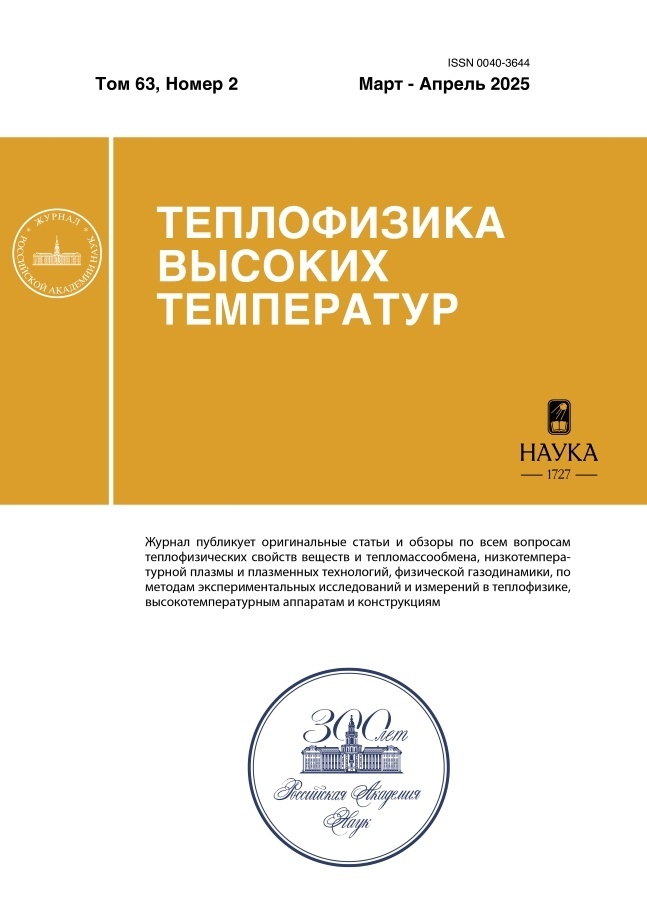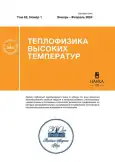Определение оптимальных параметров воздействия при микродиссекции блестящей оболочки эмбриона с помощью инфракрасных фемтосекундных лазерных импульсов
- Authors: Ситников Д.С.1, Мухдина Д.Е.1, Филатов М.А.1,2, Силаева Ю.Ю.1,2
-
Affiliations:
- ФГБУН Объединенный институт высоких температур РАН
- ФГБУН Институт биологии гена РАН
- Issue: Vol 62, No 1 (2024)
- Pages: 121-130
- Section: New energy and modern technologies
- URL: https://modernonco.orscience.ru/0040-3644/article/view/653039
- DOI: https://doi.org/10.31857/S0040364424010147
- ID: 653039
Cite item
Abstract
В настоящей работе диссекция блестящей оболочки эмбриона мыши осуществлялась с использованием фемтосекундных лазерных импульсов инфракрасного диапазона спектра (длина волны излучения – 1028 нм, длительность – 280 фс, частота следования импульсов – 2.5 кГц). Работа посвящена исследованию c помощью оптической микроскопии зависимости ширины надреза D, формируемого лазерным излучением, от энергии E лазерных импульсов и скорости υ перемещения луча. Впервые показано, что одно и то же значение ширины надреза может быть получено при различном сочетании указанных параметров. Предложено аналитическое выражение для описания зависимости ширины формируемого надреза на блестящей оболочке D(E, υ) при заданной частоте следования лазерных импульсов 2.5 кГц. Определены границы применимости функционала D(E, υ), которые охватывают значительный диапазон скорости лазерного луча 0.25 ≤ υ ≤ 100 мкм/с, а также перекрывают диапазон энергий от минимальных значений, соответствующих началу появления надреза, вплоть до возникновения оптического пробоя водной среды 115 ≤ E ≤ 190 нДж. Полученные результаты позволяют получить быструю оценку ширины планируемого надреза для любой комбинации параметров E и υ при микрохирургии блестящей оболочки эмбриона в рамках различных вспомогательных репродуктивных технологий.
Full Text
About the authors
Д. С. Ситников
ФГБУН Объединенный институт высоких температур РАН
Author for correspondence.
Email: Sitnik.ds@gmail.com
Russian Federation, Москва
Д. Е. Мухдина
ФГБУН Объединенный институт высоких температур РАН
Email: Sitnik.ds@gmail.com
Russian Federation, Москва
М. А. Филатов
ФГБУН Объединенный институт высоких температур РАН; ФГБУН Институт биологии гена РАН
Email: Sitnik.ds@gmail.com
Russian Federation, Москва; Москва
Ю. Ю. Силаева
ФГБУН Объединенный институт высоких температур РАН; ФГБУН Институт биологии гена РАН
Email: Sitnik.ds@gmail.com
Russian Federation, Москва; Москва
References
- Ricardo Loret de Mola J., Garside W.T., Bucci J., Tureck R.W., Heyner S. Analysis of the Human Zona Pellucida During Culture: Correlation with Diagnosis and the Preovulatory Hormonal Environment // J. Assist. Reprod. Genet. 1997. V. 14. № 6. P. 332.
- Krivonogova A.S., Bruter A.V., Makutina V.A., Okulova Y.D., Ilchuk L.A., Kubekina M.V., Khama-tova A.Y. et al. AAV Infection of Bovine Embryos: Novel, Simple and Effective Tool For Genome Editing // Theriogenology. 2022. V. 193. P. 77.
- Davidson L.M., Liu Y., Griffiths T., Jones C., Coward K. Laser Technology in the ART Laboratory: A Narrative Review // Reprod. Biomed. Online. 2019. V. 38. № 5. P. 725.
- Tadir Y., Douglas-Hamilton D.H. Laser Effects in the Manipulation of Human Eggs and Embryos for in Vitro Fertilization // Methods Cell Biol. 2007. V. 82. № 6. P. 409.
- Schimmel T., Cohen J., Saunders H., Alikani M. Laser-assisted Zona Pellucida Thinning Does Not Facilitate Hatching and May Disrupt the in Vitro Hatching Process: A Morphokinetic Study in the Mouse // Hum. Reprod. 2014. V. 29. № 12. P. 2670.
- Douglas-Hamilton D.H., Conia J. Thermal Effects in Laser-Assisted Pre-Embryo Zona Drilling // J. Biomed. Opt. 2001. V. 6. № 2. P. 205.
- Чефонов О.В., Овчинников А.В., Агранат М.Б. Электрооптический эффект в кремнии, наведенный импульсом терагерцевого излучения // ТВТ. 2021. Т. 59. № 6. С. 844.
- Овчинников А.В., Чефонов О.В., Агранат М.Б. Генерация второй оптической гармоники в кремнии при воздействии терагерцевого импульса с высокой напряженностью электрического поля // ТВТ. 2022. Т. 60. № 5. С. 666.
- Vicario C., Shalaby M., Hauri C.P. Subcycle Extreme Nonlinearities in GaP Induced by an Ultrastrong Terahertz Field // Phys. Rev. Lett. 2017. V. 118. № 8. P. 083901.
- Jazbinsek M., Puc U., Abina A., Zidansek A. Organic Crystals for THz Photonics // Appl. Sci. 2019. V. 9. № 5. P. 882.
- Струлёва Е.В., Комаров П.С., Евлашин С.А., Ашитков С.И. Поведение магниевого сплава при высокоскоростной деформации под действием ударно-волновой нагрузки // ТВТ. 2022. Т. 60. № 5. С. 793.
- Струлёва Е.В., Комаров П.С., Евлашин С.А., Ашитков С.И. Высокоскоростное разрушение пленок кобальта под действием нагрузок, создаваемых пикосекундным лазерным импульсом // ТВТ. 2023. Т. 61. № 6. С. 536.
- Ашитков С.И., Струлева Е.В., Комаров П.С., Евлашин С.А. Ударное сжатие молибдена при воздействии ультракоротких лазерных импульсов // ТВТ. 2023. Т. 61. № 5. С. 790.
- Zuanetti B., McGrane S.D., Bolme C.A., Prakash V. Measurement of Elastic Precursor Decay in Pre-Heated Aluminum Films under Ultra-fast Laser Generated Shocks // J. Appl. Phys. 2018. V. 123. P. 195104.
- Колобов Ю.Р., Корнеева Е.А., Кузьменко И.Н., Скоморохов А.Н., Кудряшов С.И., Ионин А.А., Макаров С.В. и др. Влияние поверхностной обработки фемтосекундным импульсным лазерным излучением на механические свойства субмикрокристаллического титана // ЖТФ. 2018. Т. 88. № 3. С. 396.
- Ашитков С.И., Иногамов Н.А., Комаров П.С., Петров Ю.В., Ромашевский С.А., Ситников Д.С., Струлёва Е.В., Хохлов В.А. Сверхбыстрый перенос энергии в металлах в сильно неравновесном состоянии, индуцируемом фемтосекундными лазерными импульсами субтераваттной интенсивности // ТВТ. 2022. Т. 60. № 2. С. 218.
- Radue E.L., Tomko J.A., Giri A., Braun J.L., Zhou X., Prezhdo O.V., Runnerstrom E.L., Maria J.-P., Hopkins P.E. Hot Electron Thermoreflectance Coefficient of Gold During Electron Phonon Nonequilibrium // ACS Photonics. 2018. V. 5. № 12. P. 4880.
- Ильина И.В., Овчинников А.В., Чефонов О.В., Ситников Д.С., Агранат М.Б., Микаелян А.С. Бесконтактная микрохирургия клеточных мембран с помощью фемтосекундных лазерных импульсов для оптоинъекции в клетки заданных веществ // Квантовая электроника. 2013. Т. 43. № 4. С. 365.
- Davis A.A., Farrar M.J., Nishimura N., Jin M.M., Schaffer C.B. Optoporation and Genetic Manipulation of Cells Using Femtosecond Laser Pulses // Biophys. J. Biophysical Society. 2013. V. 105. № 4. P. 862.
- Kumar P., Nagarajan A., Uchil P.D. Introducing Genes into Cultured Mammalian Cells // Cold Spring Harb. Protoc. 2019. V. 2019. № 11. P. 715.
- Agarwal K., Hatch K. Femtosecond Laser Assisted Cataract Surgery: A Review // Semin. Ophthalmol. 2021. V. 36. № 8. P. 618.
- Latz C., Asshauer T., Rathjen C., Mirshahi A. Femtosecond-laser Assisted Surgery of the Eye: Overview and Impact of the Low-energy Concept // Micromachines. 2021. V. 12. № 2. P. 122.
- Ilina I.V., Sitnikov D.S. From Zygote to Blastocyst: Application of Ultrashort Lasers in the Field of Assisted Reproduction and Developmental Biology // Diagnostics. 2021. V. 11. № 10. P. 1897.
- Ilina I.V., Sitnikov D.S. Application of Ultrashort Lasers in Developmental Biology: A Review // Photonics. 2022. V. 9. № 12. P. 914.
- Raghunathan R., Singh M., Dickinson M.E., Larin K.V. Optical Coherence Tomography for Embryonic Imaging: A Review // J. Biomed. Opt. 2016. V. 21. № 5. P. 50902.
- Borile G., Sandrin D., Filippi A., Anderson K.I., Romanato F. Label-free Multiphoton Microscopy: Much More Than Fancy Images // Int. J. Mol. Sci. 2021. V. 22. № 5. P. 2657.
- Vogel A., Venugopalan V. Mechanisms of Pulsed Laser Ablation of Biological Tissues // Chem. Rev. 2003. V. 103. № 2. P. 577.
- Vogel A., Noack J., Hüttman G., Paltauf G. Mechanisms of Femtosecond Laser Nanosurgery of Cells and Tissues // Appl. Phys. B. 2005. V. 81. № 8. P. 1015.
- Ситников Д.С., Ильина И.В., Пронкин А.А. Оценка теплового воздействия лазерных импульсов фемто- и миллисекундной длительности при выполнении микрохирургических процедур на эмбрионах млекопитающих // Квантовая электроника. 2022. Т. 52. № 5. С. 482.
- Ilina I.V., Khramova Y.V., Filatov M.A., Sitnikov D.S. Application of Femtosecond Laser Microsurgery in Assisted Reproductive Technologies for Preimplantation Embryo Tagging // Biomed. Opt. Exp. 2019. V. 10. № 6. P. 2985.
- Ilina I.V., Khramova Y.V., Filatov M.A., Sitnikov D.S. Femtosecond Laser Is Effective Tool for Zona Pellucida Engraving and Tagging of Preimplantation Mammalian Embryos // J. Assist. Reprod. Genet. 2019. V. 36. № 6. P. 1251.
- Ilina I.V., Khramova Y.V., Filatov M.A., Semenova M.L., Sitnikov D.S. Application of Femtosecond Laser Scalpel and Optical Tweezers for Noncontact Biopsy of Late Preimplantation Embryos // High Temp. 2015. V. 53. № 6. P. 804.
- Ilina I.V., Khramova Y.V., Filatov M.A., Semenova M.L., Sitnikov D.S. Femtosecond Laser Assisted Hatching: Dependence of Zona Pellucida Drilling Efficiency and Embryo Development on Laser Wavelength and Pulse Energy // High Temp. 2016. V. 54. № 1. P. 46.
- Sitnikov D.S., Filatov M.A., Ilina I.V. Optimal Exposure Parameters for Microsurgery of Embryo Zona Pellucida Using Femtosecond Laser Pulses // Appl. Sci. 2023. V. 13. № 20. P. 11204.
- Ильина И.В., Овчинников А.В., Ситников Д.С., Ракитянский М.М., Агранат М.Б., Храмова Ю.В., Семенова М.Л. Применение фемтосекундных лазерных импульсов в биомедицинских клеточных технологиях // ТВТ. 2013. Т. 51. № 2. С. 198.
- Sitnikov D.S., Ovchinnikov A.V., Ilina I.V., Chefonov O.V., Agranat M.B. Laser Microsurgery of Cells by Femtosecond Laser Scalpel and Optical Tweezers // High Temp. 2014. V. 52. № 6. P. 803.
- Ситников Д.С., Ильина И.В., Филатов М.А., Силаева Ю.Ю. Исследование влияния микродиссекции блестящей оболочки эмбрионов млекопитающих на ее толщину // Вестн. РГМУ. 2023. № 1. С. 41.
- Liu J.M. Simple Technique for Measurements of Pulsed Gaussian-beam Spot Sizes // Opt. Lett. 1982. V. 7. № 5. P. 196.
- Ilina I.V., Khramova Y.V., Ivanova A.D., Filatov M.A., Silaeva Y.Y., Deykin A. V., Sitnikov D.S. Controlled Hatching at the Prescribed Site Using Femtosecond Laser for Zona Pellucida Drilling at the Early Blastocyst Stage // J. Assist. Reprod. Genet. 2021. V. 38. № 2. P. 517.
- Joglekar A.P., Liu H.H., Meyhofer E., Mourou G., Hunt A.J. Optics at Critical Intensity: Applications to Nanomorphing // Proc. Natl. Acad. Sci. 2004. V. 101. № 16. P. 5856.
- Hoy C.L., Ferhanoglu O., Yildirim M., Kim K.H., Karajanagi S.S., Chan K.M.C., Kobler J.B., Zeitels S.M., Ben-Yakar A. Clinical Ultrafast Laser Surgery: Recent Advances and Future Directions // IEEE J. Sel. Top. Quantum Electron. 2014. V. 20. № 2. P. 242.
Supplementary files















